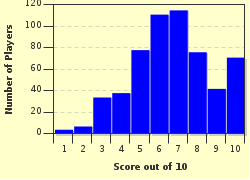Quiz Answer Key and Fun Facts
1. Most humans can only hold their breath for a few minutes. However, there is an animal which can dive to great depths for up to 2 hours! What allows this is a high concentration of haemoglobin in its blood, massive lungs, and the ability to store much oxygen in its muscles. Which animal am I describing?
2. Humans often communicate by sound. However, few human sounds are as powerful as the roar of the lion. As well as the larynx, which other morphological feature is seen as essential to the lion's ability to roar?
3. Humans have had to build machines in order to achieve flight, but to some animals this comes naturally. Which bird, the largest flying bird in the western hemisphere, only has to flap its wings a few times an hour whilst in flight due to its enormous wingspan?
4. We humans may often have trouble digesting some of our food. Which animal, because of its incredibly powerful jaws and very strong stomach acid, has little trouble with digestion?
5. The amount of time a human can spend hanging from a support varies from person to person. Not only can bats hang for amazingly long periods of time, but they can do it upside-down...whilst sleeping! Which quality of a bat allows it to do this?
6. Humans often indulge in oversized meals, and this is no different in the animal world! Which of these snakes uses its detachable jaw to swallow prey whole, after squeezing it to death?
7. If humans were to reach the speeds achieved by a peregrine falcon (up to 200 mph) in open air, they could do serious damage to their health. One such problem would be the affect of pressure on the brain due to these high speeds. How does a peregrine deal with this problem?
8. The bite of a human is fairly formidable and can even break the skin. However, in the animal world, few bites come close to that of the crocodile's in terms of power. This is due to extremely strong muscles which close its jaws. Is it true that a meagre elastic band can prevent the crocodile from opening its jaws?
9. Whereas humans have trouble coping with extremely low temperatures, some animals have evolved many adaptations to deal with it. Which animal possesses a thick layer of fat, broad paws and thick undercoat, specially adapted to cope with its arctic environment?
10. Oops, I almost didn't see this one. Whereas humans depend on body paint and clever clothing to blend into their surroundings, camouflage comes naturally to some incredible creatures. Which animal, often referred to as the chameleon of the sea, uses tiny muscles along with pigment filled sacs to constantly change colour?
Source: Author
doublemm
This quiz was reviewed by FunTrivia editor
crisw before going online.
Any errors found in FunTrivia content are routinely corrected through our feedback system.

